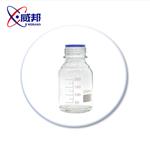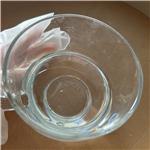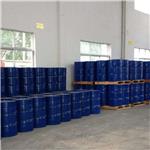Butyric anhydride, or Butanoic anhydride, is a chemical compound with the formula (CH3CH2CH2CO)2O.It is a colorless liquid that smells strongly of butyric acid, formed by its reaction with the moisture in the air.
Butyric anhydride can be used to prepare various flavor & fragrance compounds like neryl butyrate, geranyl butyrate, and butyl butyrllactate.
Butyric anhydride is used in the preparation of amidoamine dendron-based co-adsorbents, which finds application in dye- sensitized solar cells improvement. It is also used in the synthesis of butyrate ester, which is used as a perfume and flavor. Further, it acts as a fumigant to drive bees from their hives. In addition to this, it is used in food additives, textile auxiliaries, varnishes, perfumes, pharmaceuticals and disinfectants.
Manufacture of butyrates, drugs, and tanning
agents.
To a cooled flask containing 88 gm (1.0 mole) of η-butyric acid at 10°C is added dropwise 28.0 gm (0.5 mole) of methoxyacetylene over a 1-hr period. After stirring the reaction mixture for 16 hr at 20°C the contents are distilled to afford the following three fractions: (1) b.p. 56°C, η& 1.3628, 23 gm (62%), methyl acetate; (2) b.p. 72-73°C (18 mm Hg), n% 1.3990, 10.0 gm (11%), butyric acid; (3) b.p. 91-92°C (18mmHg), 1.4118, 48.0 gm (61%), butyric anhydride.

Because of its odor, butyric anhydride has use as a fumigant to drive bees from their hives in products such as Bee - Go.
Water-white liquid with an odor of rancid butter. Flash point 190°F. Density 8.0 lb / gal. Corrosive to metals and tissue. Low toxicity.
Slowly reacts with water to form butyric acid.
Butyric anhydride reacts exothermically with water. The reaction is usually slow, but might become violent if local heating accelerates their rate. Acids accelerate the reaction with water. Incompatible with acids, strong oxidizing agents, alcohols, amines, and bases.
TOXIC; inhalation, ingestion or contact (skin, eyes) with vapors, dusts or substance may cause severe injury, burns or death. Contact with molten substance may cause severe burns to skin and eyes. Reaction with water or moist air will release toxic, corrosive or flammable gases. Reaction with water may generate much heat that will increase the concentration of fumes in the air. Fire will produce irritating, corrosive and/or toxic gases. Runoff from fire control or dilution water may be corrosive and/or toxic and cause pollution.
Combustible material: may burn but does not ignite readily. Substance will react with water (some violently) releasing flammable, toxic or corrosive gases and runoff. When heated, vapors may form explosive mixtures with air: indoors, outdoors and sewers explosion hazards. Most vapors are heavier than air. They will spread along ground and collect in low or confined areas (sewers, basements, tanks). Vapors may travel to source of ignition and flash back. Contact with metals may evolve flammable hydrogen gas. Containers may explode when heated or if contaminated with water.
Mildly toxic by
ingestion. A corrosive liquid. When heated
to decomposition it emits acrid smoke and
irritating vapors.
Butyric anhydride is a combustible, corrosive liquid. It is considered water sensitive.
Dry the anhydride by shaking it with P2O5, then distilling it. [Beilstein 2 IV 802.]




